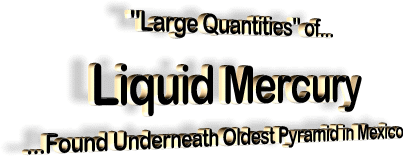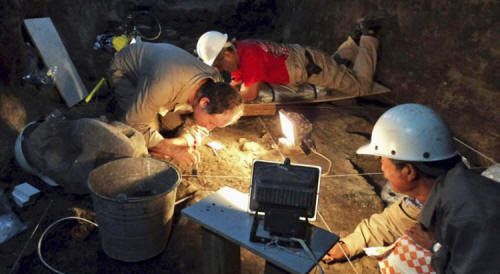|
Amazing discoveries continue to emerge from the strange world of archaeology and ancient history.
This time, an archaeologist by the name of Sergio Gomez has discovered "large quantities" of liquid mercury in a chamber underneath the third largest pyramid of Teotihuacan (feathered serpent), a very ancient city located in Mexico.
The city is commonly referred to as the abode of the gods in the ancient language Nahuatl.
Approximately 200,000 people are thought to have lived there between 100 and 700 A.D. Little is known about its people or how they mysteriously disappeared without a trace, as with so many other ancient civilizations.
According to the Guardian:
This isn't the first time a discovery like this has been made. Liquid Mercury has been found at three other sites around Central America.
In "The Early Classic Period at Caracol", there is another example that comes from Belize, where an equally striking find of liquid mercury was cached under the central ball-court marker.
These are very interesting discoveries that further add to the already complex mystery of the Pyramid structures that exist not only in Mexico, but all over the world.
There are so many unanswered questions, and the liquid mercury aspect just adds more pieces to the puzzle.
What Does This Mean? Why Did They Use Liquid Mercury?
Rosemary Joyce, a professor of anthropology at the University of California, Berkeley, said that archaeologists have found mercury at three other sites around Central America.
So this isn't something new. But why?
One explanation, outlined in research (Lodestone Compass - Chinese or Olmec Primacy?) published in Science in 1975 by archeo-astronomer John Carlson, demonstrated that a hematite object excavated at the Olmec site of San Lorenzo, in the Gulf Coast of Mexico could act as a compass oriented to magnetic north if it was floated on liquid mercury.
Carlson suggested that the Olmec might have used liquid mercury for this purpose. Other scholars have stated with absolute certainty that liquid mercury was used starting at approximately 1000 BC.
That being said, as Professor Joyce points out,
They've been reported from the Highland Mexican site Chalcatzingo, dating before 900 BC.
But these large quantities of liquid mercury didn't come until a bit later.
According to Gomez in an interview he did with Reuters, the mercury might have symbolized an underworld river or lake. This theory comes from the fact that liquid mercury is like looking into a mirror - it's very reflective and, according to experts, mirrors were considered a means by which one could view the supernatural world.
According to Newsweek:
Another very interesting point made by some scholars is the idea that:
Sources
|

